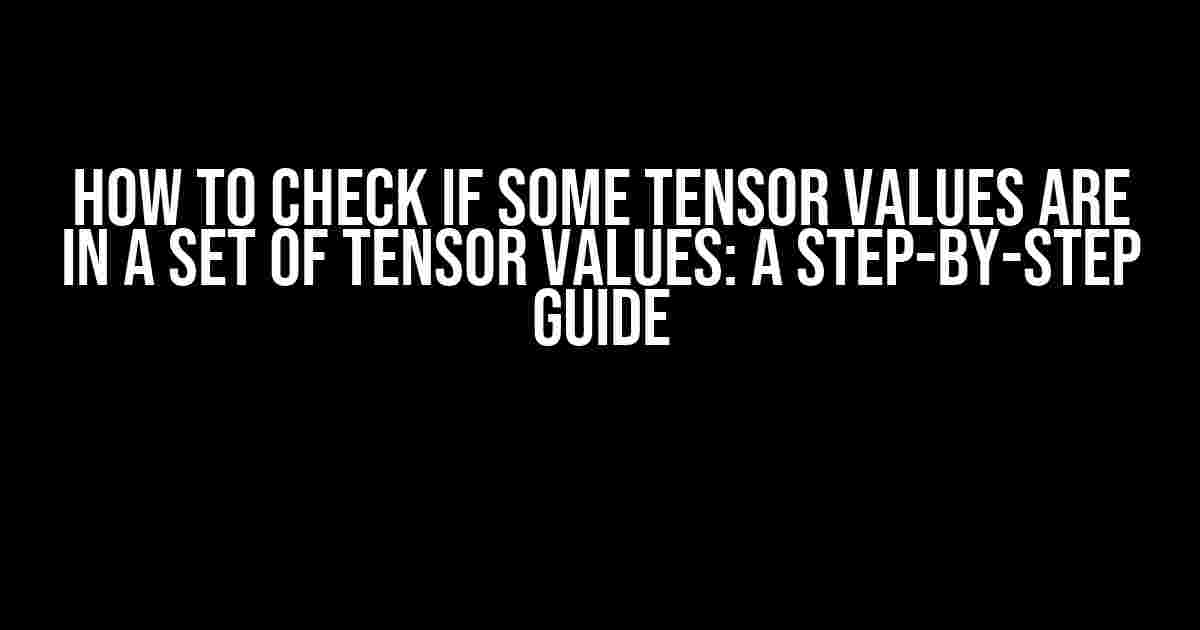As a machine learning enthusiast, you’ve probably encountered situations where you need to determine if certain tensor values exist within a larger set of tensor values. This task might seem daunting, especially when dealing with large datasets and complex tensor operations. Fear not, dear reader! This comprehensive guide will walk you through the process of checking if some tensor values are in a set of tensor values, making you a tensor-taming master in no time.
Understanding Tensors and Sets
Before diving into the main topic, let’s quickly review the basics of tensors and sets.
A tensor is a multi-dimensional array of numerical values, often used in machine learning and deep learning applications. Think of it as a matrix on steroids! Tensors can have any number of dimensions, making them a powerful tool for representing complex data structures.
A set, on the other hand, is an unordered collection of unique elements. In the context of tensors, a set of tensor values refers to a collection of unique tensor elements.
Why Check if Tensor Values are in a Set?
There are several scenarios where you might need to check if certain tensor values exist within a set of tensor values:
- Data Preprocessing**: During data preprocessing, you might want to remove duplicate or unwanted tensor values from a dataset. By checking if a tensor value is in a set of tensor values, you can identify and remove redundant data.
- Feature Engineering**: When creating new features from existing ones, you might need to determine if certain tensor values satisfy specific conditions. Checking if tensor values are in a set helps you make informed decisions about feature engineering.
- Model Evaluation**: During model evaluation, you might want to check if the predicted tensor values are within a set of acceptable values. This ensures that your model is producing accurate results.
Methods for Checking if Tensor Values are in a Set
Now that we’ve covered the basics, let’s explore the various methods for checking if tensor values are in a set of tensor values.
Method 1: Using the `in` Operator
The most straightforward approach is to use the `in` operator, which checks if a tensor value is present in a set of tensor values.
import tensorflow as tf
# Define a tensor
tensor = tf.constant([1, 2, 3, 4, 5])
# Define a set of tensor values
set_tensor_values = tf.constant([2, 4, 6, 8, 10])
# Check if tensor values are in the set
result = tfambre tensor in set_tensor_values
print(result) # Output: [False, True, False, True, False]
In this example, the `in` operator checks if each element of the `tensor` is present in the `set_tensor_values`. The result is a boolean tensor indicating whether each element is in the set or not.
Method 2: Using the `tf.sets` Module
TensorFlow provides the `tf.sets` module, which offers more advanced set operations, including checking if tensor values are in a set.
import tensorflow as tf
# Define a tensor
tensor = tf.constant([1, 2, 3, 4, 5])
# Define a set of tensor values
set_tensor_values = tf.constant([2, 4, 6, 8, 10])
# Check if tensor values are in the set using tf.sets
result = tf.sets.contains(set_tensor_values, tensor)
print(result) # Output: [False, True, False, True, False]
In this example, the `tf.sets.contains` function takes two arguments: the set of tensor values and the tensor to check. The result is a boolean tensor indicating whether each element of the tensor is in the set or not.
Method 3: Using the `tf.map_fn` Function
Another approach is to use the `tf.map_fn` function, which applies a function element-wise to a tensor.
import tensorflow as tf
# Define a tensor
tensor = tf.constant([1, 2, 3, 4, 5])
# Define a set of tensor values
set_tensor_values = tf.constant([2, 4, 6, 8, 10])
# Define a function to check if a value is in the set
def check_in_set(x):
return x in set_tensor_values
# Apply the function element-wise using tf.map_fn
result = tf.map_fn(check_in_set, tensor)
print(result) # Output: [False, True, False, True, False]
In this example, the `check_in_set` function takes an element of the tensor as input and checks if it’s in the set of tensor values. The `tf.map_fn` function applies this function element-wise to the tensor, returning a boolean tensor indicating whether each element is in the set or not.
Best Practices and Optimization
When checking if tensor values are in a set, keep the following best practices and optimization techniques in mind:
- Use the `tf.sets` module for large datasets**: When dealing with large datasets, using the `tf.sets` module can provide significant performance gains.
- Vectorize operations**: Use vectorized operations whenever possible to speed up computations.
- Avoid using Python loops**: Python loops can be slow and inefficient. Instead, use TensorFlow’s built-in functions and operations to perform computations.
- Use GPU acceleration**: If possible, use GPU acceleration to speed up computations.
Conclusion
In this comprehensive guide, we’ve explored the different methods for checking if tensor values are in a set of tensor values. Whether you’re working with small datasets or large-scale machine learning models, understanding these techniques will help you become more efficient and effective in your work. Remember to follow best practices and optimization techniques to get the most out of your computations.
| Method | Description | Code Example |
|---|---|---|
| Using the `in` Operator | Checks if a tensor value is in a set of tensor values | result = tf tensor in set_tensor_values |
| Using the `tf.sets` Module | Provides advanced set operations, including checking if tensor values are in a set | result = tf.sets.contains(set_tensor_values, tensor) |
| Using the `tf.map_fn` Function | Applies a function element-wise to a tensor to check if values are in a set | result = tf.map_fn(check_in_set, tensor) |
Now, go forth and conquer the world of tensors and sets!
Frequently Asked Question
Taking a deep dive into the world of tensors? Here are some frequently asked questions about checking if some tensor values are in a set of tensor values.
How do I check if a tensor value is in a set of tensor values?
You can use the `in` operator or the `tfEQUAL` function from the TensorFlow library. For example, if you have a tensor `x` and a set of tensor values `tensor_set`, you can use `x in tensor_set` or `tf.equal(x, tensor_set)` to check if `x` is in `tensor_set`.
What is the difference between `in` operator and `tfEQUAL` function?
The `in` operator checks if the tensor value is present in the set, while the `tfEQUAL` function checks if the tensor value is equal to any of the values in the set. In other words, `in` checks for membership, while `tfEQUAL` checks for exact equality.
Can I use NumPy functions to check if a tensor value is in a set of tensor values?
Yes, you can use NumPy functions such as `np.in1d` or `np.isin` to check if a tensor value is in a set of tensor values. However, keep in mind that these functions will convert the tensor to a NumPy array, which may incur a performance overhead.
How can I check if multiple tensor values are in a set of tensor values?
You can use the `tf.equal` function with the `tf.reduce_any` function to check if any of the tensor values are in the set. For example, `tf.reduce_any(tf.equal(tensor_values, tensor_set))` will return `True` if any of the values in `tensor_values` are in `tensor_set`.
What if I want to check if all tensor values are in a set of tensor values?
You can use the `tf.equal` function with the `tf.reduce_all` function to check if all tensor values are in the set. For example, `tf.reduce_all(tf.equal(tensor_values, tensor_set))` will return `True` if all values in `tensor_values` are in `tensor_set`.



